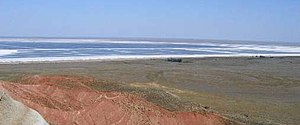Baskuntschak
| Baskuntschak | ||
|---|---|---|

|
||
| View from the Bolshoye Bodgo mountain to part of the Baskuntschak salt lake | ||
| Geographical location | Russia | |
| Data | ||
| Coordinates | 48 ° 13 ' N , 46 ° 53' E | |
|
|
||
| surface | 115 km² | |
The Baskuntschak ( Russian Баскунчак ) is a 115 km² salt lake in the Astrakhan Oblast in Russia , about 270 kilometers north of the Caspian Sea and 53 kilometers east of the Volga .
Location and description
The lake is located in a local depression 21 m below sea level (corresponding to 7 m above the level of the Caspian Sea). The river Gorkaya Retschka ( Russian Горькая Речка , "bitter river") with a catchment area of 11,000 km² flows into the outflow-free lake . It is also fed from 25 saline springs. The salt content of the lake is around 300 g / l. That is why there are no fish in the lake, but bacteria that tolerate salt. The daily salt input into the lake is given as 2.5 thousand tons.
At the southern end of the lake the mountain Bolshoye Bogdo rises. With a height of 150 m, it is the highest point in the Caspian Depression . The mountain is pushed up 1 mm year after year by an underground salt dome. Karst caves up to 1.5 km in length and numerous sinkholes criss- cross the mountain. On this mountain, deposits of the Triassic were first detected for the territory of Russia in 1831 . It is sacred to the local Kalmyks .
Since 1997, an area of 53.7 hectares on the Baskuntschak has been protected as a nature reserve .
The salt is very aggressive and destroys iron tools and vehicle parts in a very short time. Specially constructed railway wagons from a specially built railway line and cars with oversized wheels are in use. People generally tolerate the salty air, which is also enriched with bromine and volatile components, well.
history
The salt lake was formed at a place that was covered by water near the northern shoreline of the Paratethys in the Palaeogene and Neogene and fell dry as a lagoon.
Salt has been mined since the 8th century and was later transported away via the branches of the Silk Road in this area . The salt mining (the salt harvest ) was not initially carried out by the sparse local population, but by emissaries from distant towns and villages. The extracted high-quality salt (99.8 percent NaCl ) from the lake covers 80 percent of Russia's salt needs. Depending on demand, between 1.5 and 5 million tons of salt are mined annually. For the local population, this work is now the only source of income. In 1627, the village of Baskuntschak and the lake were first mentioned in the Book of Great Drawings - a first geographical description of Russia - as a place "where the salt is as clean and white as ice."
Between 1960 and 1963, a 20 km oval for car races was maintained on the lake in order to be able to set new speed records. During the period mentioned, 29 records were recorded, the absolute All-Union record of 311.4 km / h from 1963 was particularly noteworthy. The racing driver Tichomirow used a Pionier-2 vehicle . If necessary, part of the route can be reactivated.
Use of the lake
Near the lake there are the villages of Upper Baskunchak, middle and lower-Baskunchak and the sanatorium Baskunchak .
Tourists and people with all kinds of diseases come here in July and August. The relatively cold water of the lake was discovered early due to its salt content to heal respiratory and skin diseases. However, care must be taken that the sharp-edged salt crystals do not injure the limbs and that no seawater gets into the eyes, which is said to have led to blindness.
Web links
- Parkland Baskunchak (English)


